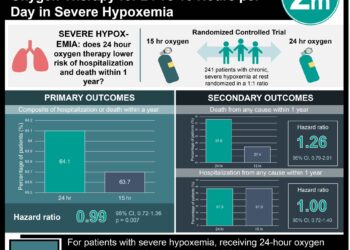Arterial hyperoxia associated with mortality in critically ill children admitted to the pediatric intensive care unit
1. This large systematic review and meta-analysis of 16 studies and 27 555 patients found that, among critically ill children admitted to the pediatric intensive care unit, administration of supplemental oxygen causing hyperoxia was associated with increased mortality.
2. Future research is required to examine the implications of this formative association and its complex translation into critical care guidelines and practice.
Evidence Rating Level: 1 (Excellent)
Study Rundown: The administration of supplemental oxygen is one of the mainstay therapies in pediatric critical care. However, there is increasing evidence to show that over-administration of oxygen in critical situations leading to hyperoxia may be associated with detrimental outcomes compared to targeted normoxia. This study evaluated the association between hyperoxia and outcomes in critically ill children admitted to the pediatric intensive care unit (PICU) with the hypothesis that hyperoxia was associated with worse outcomes. The primary outcome was 28-day mortality and secondary outcomes included length of stay, ventilator-related outcomes, extracorporeal organ support, and functional performance. After completing a systematic review of 16 studies and meta-analysis of 11 studies comprising 23,204 total patients, hyperoxia was associated with an elevated odds ratio for mortality in this patient population. These findings suggested that oxygen above a certain dose may be harmful in critically ill children and should be supplied with caution. A limitation of this study was the substantial heterogeneity in the definition of hyperoxia used by the various studies as well as the observational and retrospective design of most selected studies, owing to a degree of subjectivity and interpretation of data that may affect statistical precision.
Click to read the study in JAMA Network Open
Relevant Reading: Arterial hyperoxia and mortality in critically ill patients: a systematic review and meta-analysis
In-Depth [systematic review and meta-analysis]: This systematic search of EMBASE, MEDLINE, Cochrane Library, and ClinicalTrials.gov included 16 studies (27,555 patients) on outcomes of children admitted to the PICU with hyperoxia from inception to February 2021. The Meta-analysis of Observational Studies in Epidemiology guideline and Newcastle-Ottawa Scale for study quality assessment was used, where 2 independent reviewers completed the review process. All studies, except 1 randomized trial, were observational cohort studies, where data was pooled together via random-effects modeling. Studies included patient populations of various etiologies including post-cardiac arrest, traumatic brain injury, extracorporeal membrane oxygenation, and general critical care, where partial pressure of arterial oxygen was most frequently used to define hyperoxia. Among 11 studies (23,204 patients) included in the meta-analysis, hyperoxia was associated with an odds ratio of 1.59 (95%CI, 1.00-2.51; after Hartung Knapp adjustment, 95%CI, 1.05-2.38) for mortality with substantial between-study heterogeneity (I2 = 92%) and among less heterogeneous subsets. When data was pooled by definition of hyperoxia, a signal of harm was observed at higher thresholds of arterial oxygen levels.
Image: PD
©2022 2 Minute Medicine, Inc. All rights reserved. No works may be reproduced without expressed written consent from 2 Minute Medicine, Inc. Inquire about licensing here. No article should be construed as medical advice and is not intended as such by the authors or by 2 Minute Medicine, Inc.







